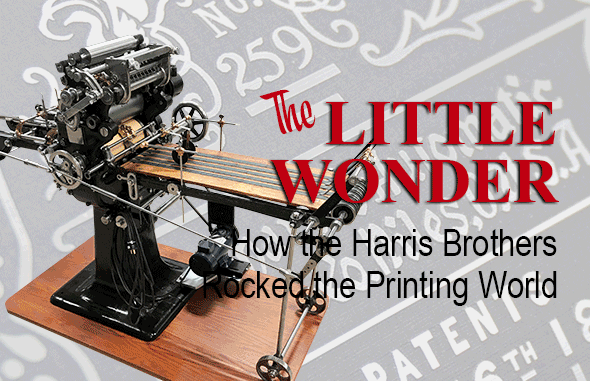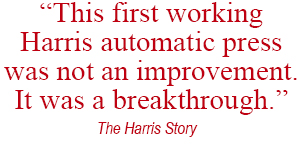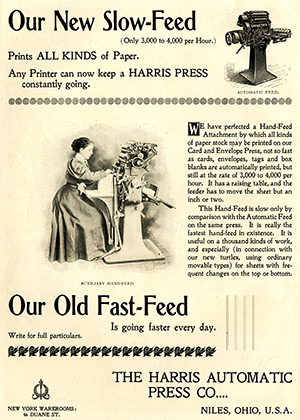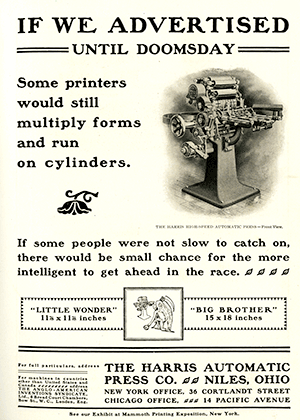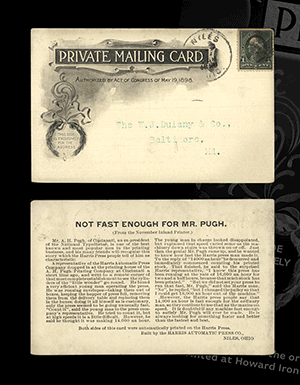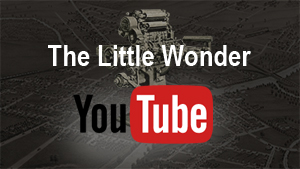
|
|
| Home › Articles › Here |
|

|
||||||||
| By: Nick Howard | Date: March 2019 | Contact the Author | |||||||||
|
n the sleepy Ohio town of Niles, brothers Alfred and Charles Harris owned a small jewelry store. The year was 1890, and after several blunders, including an ill-fated attempt inventing an automatic nail-feeder, both swore off any more financial fiascos. The 1972 book The Harris Story tells us what happened next. It seems Charles couldn’t help himself when he got to talking to the next-door neighbour — the owner of the Niles Independent newspaper. Mr. Smith boasted he had just purchased a new state-of-the-art cylinder printing press that was still fed by a boy. “You mean you’ve actually got to feed that press by hand?” exclaimed Charles. “Of course, but I can feed 25 sheets a minute,” said Smith. Unimpressed, Charles shot back, “No wonder you haven’t finished our handbills.” “Well, if you’re so damned smart, why don’t you build one,” Smith shouted back. So they did. After years of toil with liberal amounts of cussing and at times complete hopelessness, the two brothers succeeded in fashioning a crude feeding device that actually worked — well, sort of. Needing refinements, they sent it to the Carter machine shop in Niles to be built of iron. Charles took another job in town as the small jewelry shop wasn’t going to support two men with an expensive inventing habit. While Alfred ran the store, Charles continued improving the little feeder. By 1893, they had managed to save up enough money to send Charles to the Columbian World’s Fair in Chicago, Ill., where anyone who was anybody in the printing industry showcased their wares. Charles came back pumped. “There’s nothing there we can’t skin, Al, but you’d best go look too.” Alfred was more methodical compared to Charles, and he returned from Chicago with a lot of notes and sketches. This was when they also made another monumental decision to not only construct the feeder but also design a brand-new FAST printing press. This had to be revolutionary, for the Harris brothers were witness to the lethargic speeds and excessive manpower needed to print anything. Harris would create a printing press no longer inhibited with a flatbed. The concept they came up with was a revelation. The machinery of this era was either platen (hand-fed) or cylinder with reciprocating beds — slow as molasses. Bed machines wasted so much energy having to stop and return. Rotational designs could run incredibly fast with less moving parts and even less energy. Today’s offset presses are a prime example of the rotary principle. There would be no limit on how fast they could go, provided the press had an automatic feeder. E.C. Fuller and Dexter were already experimenting with feeders using negative air via a piston pump but Harris would do it all without any air, and for the first time, on a printing press automatically.
“This first working Harris automatic press was not an improvement, it was a breakthrough,” according to The Harris Story. “At a time when printers were feeding 25 sheets per minute, the Harris automatically-fed press was able to print 250 per minute, 15,000 per hour.” “We may starve to death in a gold mine. Cut it to 5,000 per hour.” The little press with a sheet size of 11 x 12 inches could feed envelopes, tags, and cards only with a thickness of no less than 0.009 inches. As the first machines were built, Charles headed for Cleveland to start selling what was now designated the E1 card press. One call was made to the J.B. Savage Co. After ending his sales pitch with the statement that the press would run 15,000 per hour, Savage burst out laughing. “When my new stock of leather medals comes in, you get the first one for champion romancer! Look, I’m very busy.”
“How fast is that press running?” asked Brooks. “About fourteen thousand an hour,” the brothers replied. “I thought you said it would do five thousand an hour!” Shocked beyond belief, Brooks forgot about the exclusivity agreement and ran off to get two competitors who happened to be visiting their office. History was made that day. “If we advertised until doomsday!” Continual improvements were made to the E1 over the next few years including attachments to feed multiple-up tags, die-cut paper box blanks, and paper bags. One unusual modification allowed the feeding of milk bottle (round) stoppers. Harris devised a second unit for numbering and perforating in one pass. But all was not well at Harris; strange things were occurring to their presses. Parts would mysteriously fall off, nails somehow fell from the ceiling and emery dust would find its way into the bushings on a lot of the sold presses. Sabotage was a worry — this revolutionary press had pressman, and especially feeders, fearing they’d be out of a job.
It wasn’t long before two roadblocks percolated to the surface with the E1. First, it could only feed substrates with a minimum thickness of .009 inches. This was soon solved in 1900 with a new feeder that was specifically adaptable for thin paper. But by far the biggest hurdle was something neither Harris brother considered — few of their customers used or had the equipment to make Stereos or copper Electros. Stereos were developed in the early 1800s and were a lead plate made from a Flong mat mold of foundry type. Large shops and large web/newspapers had the casters for this revolutionary plate but small-town printers, notoriously cheap, would not invest in casters, shavers, and routers. Without plates, the E1 was useless. Harris started offering equipment for plate-making as well as a curving device for electros. But that meant more money when the industry was still haunted by the Panic of 1893 depression. Back at the Niles factory, the Harris brothers fashioned together a crude ‘type box’ which would replace the plate cylinder and hold normal foundry type. But with the E1 cranking out at 15,000, the type would jar loose and spray out like a burst steam pipe. The type box wasn’t a success and created the biggest downfall in massive sales to jobbing printers. Regardless, spurred by some early E1 successes, Harris built a larger press in 1897 called the S1, or ‘Big Brother.’ The press would feed carton and paper with a larger sheet size of 16 x 20 inches. The S1 was almost as fast as the E1 too. In fact, a confidential company specification sheet notes that the E1 could even reach 18,000 sheets per hour. All told, Harris would build just 617 E1’s (1896-1932) and 449 S1 and S2’s (1897-1926) before ending production. 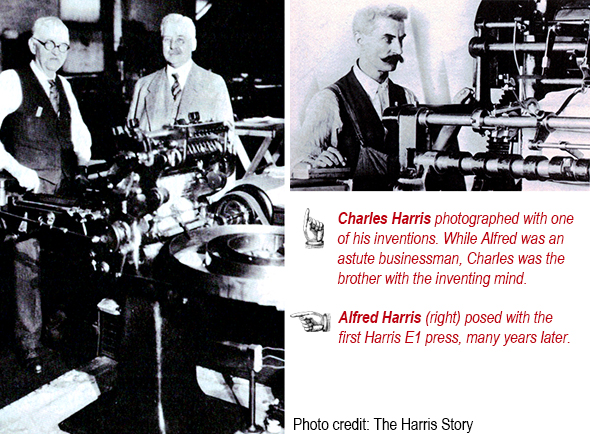 Germany’s first manufactured offset press was a Harris The S1 would open up an even bigger door when in 1904, Harris happened upon the magic of offset. During an installation of an E1 at the Enterprise Printing Company in Cleveland, Alfred would be witness to a commotion between a pressman and feeder girl over her misfeeding a sheet on a lithographic stone press. On examination, Harris noticed how much sharper the reversed image was compared to what was printed directly from the stone. Harris hurried back and by 1905, had modified the S1 with an additional blanket cylinder to become its first offset press: model S4L (L for litho). At the time Harris employed a German immigrant named Casper Hermann. Having arrived from Königsberg, Germany, in 1889, Hermann bounced around print shops in Baltimore and Richmond before ending up in Niles. Being witness to the new letterpress/offset S1, Hermann returned to Germany in 1907 where he would become the first German to build what was a copy of the Harris offset press – the Triumpf. Germany’s first offset press was a Harris! 
The press doesn’t have any ball bearings or a vacuum pump. All it needs is a ½ HP drive motor. There are only five taper pins — everything else is keyed with set screws. The ‘Wobble Gear’ for oscillation of the inker drum started with this E1 as did patented feed-rolls for sheet register. The press could be tripped off impression if it missed a sheet — unheard of then, taken for granted today. All of these Harris construction methods remained to the very last Redaelli Tecna Offset Aurelia that rolled off the line around 1996. Harris had sold off its sheetfed offset business to the Italians in 1975. The shuttle feeder remains the real piece of brilliance. If you have a mailing department, take a look at the feeder. That device is thanks to Harris. Today’s manufacturers – Morgana, Kirk-Rudy, Sitma, Buhrs, and Cheshire to name a few – use the Harris principle top-load-bottom-feed device. A special thank you to Richard Foley, Harris, and Joan Boudreau, curator of the Graphic Arts Collection, National Museum of American History, Smithsonian Institution, Washington. She was patient and instrumental in assisting us in bringing back a part of print’s history. |
|||||||||
| Contact the Author | |||||||||
|
|||||||||||||||
